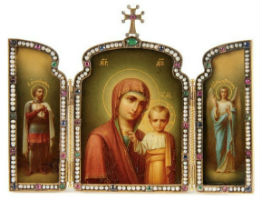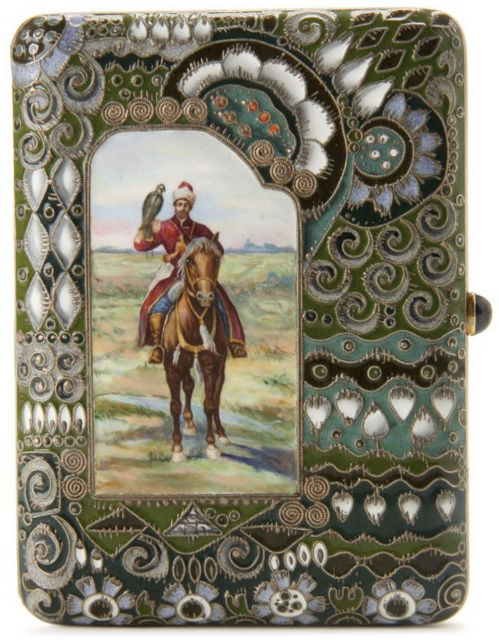
NEW YORK — Faberge is famous for its imperial Easter eggs but the talented workmasters there also transformed ordinary items into stunning objects from cigarette cases and desk clocks to small boxes, vases and candelabra. Achieving renown through Europe’s royal courts and then around the world, the company is noted for its goldsmithing, stone-setting and its distinctive enameling methods.
The company began as a jewelry firm in 1842 in St. Petersburg, Russia, by Gustav Faberge, using the accented name “Fabergé,” reportedly because he thought the accent made his name seem stylish or he adopted that spelling as “ge” is pronounced “jay” in Russian. The firm truly came into its own however after Gustav’s son, Peter Carl Faberge, and his brother Agathon, took over in 1882. They brought Faberge to new heights they probably couldn’t have even imagined and revolutionized the jewelry business itself in the process.
“Out went the then fashionable style where diamonds prevailed. In came the design-led artist-jeweler with a penchant for color through both stones and reviving the lost art of enameling,” according to a company history on Faberge.com. “They added objets deluxe to their repertoire, including objets de fantaisie such as the Imperial Easter Eggs, now regarded as pinnacles of the goldsmiths’ art. Today these are treasured in some of the world’s leading museums and private collections.”
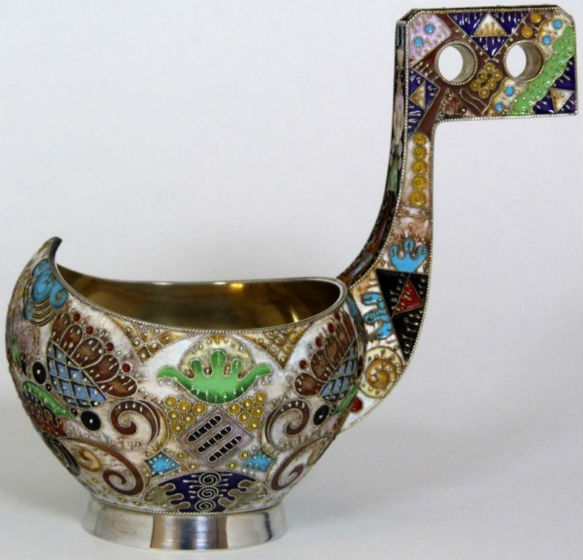
Picture a Faberge object and what comes to mind? Glittering ornate objects, like the imperial eggs, made of the finest gold or silver, and usually enameled with sophisticated techniques and set with colorful hardstones. Faberge was the height of luxury and even competitors like Tiffany and Cartier sat up and paid notice.
And what about those eggs?
Faberge’s series of 50 Imperial Easter eggs, made between 1885 and 1916, began when Emperor Alexander III, through an envoy of his uncle, the Grand Duke Vladimir, commissioned Faberge to make an Easter egg as a gift for his young bride, Maria Feodorovna. While Fabergé reportedly planned the ring to contain a surprise item of a diamond ring, the finished “hen” egg contained a gold yolk, a gold hen, and a ruby pendant instead of a diamond, as requested by the emperor.
The gift was so pleasing to both the giver and the recipient that Faberge was commissioned to make one each year, with the only guidance from the emperor that each egg contain a surprise. It apparently took a year to make each egg and was crafted in secret so that the emperor didn’t know its design until it was hand delivered. So began Faberge’s relationship with the royal family.
“These creations are inextricably linked to the glory and tragic fate of the last Romanov family,” according to Faberge.com. “They were the ultimate achievement of the renowned Russian jewelry house and must also be considered the last great commissions of objets d’art. Ten eggs were produced from 1885 to 1893, during the reign of Emperor Alexander III; 40 more were created during the rule of his dutiful son, Nicholas II, two each year, one for his mother, the dowager, the second for his wife.”

One of the techniques Faberge specialized in was the guilloche technique which creates an elaborate engraved pattern, over which enamel is usually applied. According to eBay, it’s commonly thought that guilloche (pronounced gee-oh-shay from the French word meaning “engine turning”) was a kind of enameling when it actually is a process. “Guilloché patterns can be seen in neoclassic architecture and banknotes (in an effort to deter forgery). The technique as it pertains to jewelry-making involves carving a design into a base metal. Today true guilloché can be found in mostly luxury watches and then only a very few companies practice the art. The guilloché technique can be seen in various antique and vintage jewelry and vanity items from compacts, pocket watches and dresser sets to charms.”
Another enameling technique Faberge mastered was en ronde bosse (in the round). “In the late 14th century in France, craftsmen developed the technique of enameling the entire surface of small handcrafted objects,” said James L. Jackson, CEO of Jackson’s International Auctioneers & Appraisers, Cedar Falls, Iowa. “This new technique was also employed by the workshop of Faberge who helped revive this ancient method with new colors and elaborate designs. The art of enameling on a whole is ancient and can be found in early Egyptian, Asian and Byzantium works, all of which were drawn upon by Faberge as inspiration for his works.”
Faberge works evolved over time and the company employed many craftsmen and head workmasters over the year. Hallmarks are crucial in understanding objects by the Faberge firm and other objects of art.
However, one must be aware that there exist forged or deceptive “hallmarks,” said Barry Shifman, curator, Decorative Arts 1890 to the present, at the Virginia Museum of Fine Arts in Richmond, which has the largest public collection of Fabergé and Russian decorative arts in an American museum. It includes about 200 objects by or attributed to the Fabergé firm, as well as “Old Russian”-style works, such as silver and enamels, by Feodor Rückert and other masters.
“While scholarly books illustrate most of the relevant marks, one must also be aware of other aspects of a work of art: for instance, does the ‘style’ conform to what is being purported; is the workmaster marks consistent with the type of work shown, etc.,” said Shifman. “So, ‘hallmarks’ are just one aspect of a work of art to determine authenticity. Many factors are included, and Faberge is a very challenging artist to keep straight, as there is a market today for his work.”
According to the website titled “A Small Collection of Antique Silver and Objects of Vertu,” a list of Faberge workmasters and hallmarks includes:
- Johan Victor Aarne (1863-1934) a Finnish workmaster who created enameled gold and silver objects. He marked his objects as “JV.A.”
- Feodor Alexeievich Afanasiev specialized in tiny Easter eggs, gilt silver smalls, and guilloché enamel and hardstone objects with gilt-silver, small frames and cigarette cases. His mark is “FA” which in Russian Cyrillic is ФА.
- Karl Gustaf Hjalmar Armfeldt (1873-1959) was one of several Finnish workmasters employed by the House of Faberge who made enameled objects here up to 1916.
- August Frederik Hollming (1854-1915), who began work here in 1880. His hallmark is “A*H.”
- August Wilhelm Holmstrom (1829-1903), a Finnish workmaster named chief jeweler by Gustav Fabergé in 1857, used an “AH” mark, the same mark later adopted by his son, Albert (1876-1925).
- Erik August Kollin, (1836-1901) Fabergé’s Finnish head workmaster until 1886. His hallmark was “‘E.K.” in Latin or in Russian Cyrillic.
- G. Lundell served as head workmaster of Fabergé’s Odessa branch and used a mark of “GL” in Russian Cyrillic.
- Anders Michelson (b. 1839), a Finnish workmaster who made gold cigarette cases and small enameled objects. His hallmark was possibly “AM.”
- Gabriel Nikkanen, a Finnish workmaster, ran an independent workshop in St. Petersburg in the 1870s and in 1885, became a workmaster for Fabergé. He is known to have made small items in silver and gold, enameled frames and cigarette cases in gold and silver.
- Michael Perchin (Michael Evlampievitch Perchin), (1860-1903) is the most renowned of Fabergé’s workmasters. He oversaw the craftsmanship of the imperial Easter eggs until he died in 1903. His hallmark appears on all but the first egg made during those years. Although he was mostly trained at first by country craftsmen, his later work was sophisticated and inspired by Rococo and Louis XV styles. His hallmark was “M.P.” in Russian Cyrillic.
At its peak, the House of Faberge (which eventually had outlets in London, St. Petersburg, Moscow and Kiev) employed over two dozen well-documented workmasters, Jackson noted. “Each essentially brought to the table an understanding and mastery of certain aspects of craftsmanship in the realm of jewelry or decorative arts,” he said. “Three of the most well-known would be Erik Kollin, Mikhail Perchin and Henrik Wigstrom. For example, Wigstrom oversaw the production of Imperial Easter eggs as well as carved hardstone objects.”
“Perchin was a virtuoso in the realm of translucent enamel covering a design or pattern engraved in silver or gold (guilloche). So well respected and sought after were the works of some of Faberge employees (workmasters) that they eventually went independent but still produced works for Faberge. Most notably would be the exquisite cloisonné enameller and Pan Slavic designer Feodor Rückert (1840-1917).”
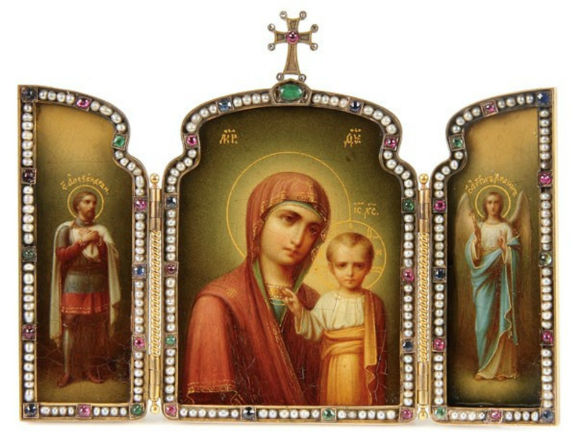
Faberge created thousands of objects besides its eggs and was one of the most important and largest jewelry establishments in Europe during the late 19th century. “Besides beautiful jewelry, the company made other decorative objects, such as silver, jeweled objects of art,” Shifman said. “The main ‘style’ of works of art made in the St. Petersburg establishment were in the neoclassical – or French – style associated with Paris. Works made in the Moscow establishment were in the ‘Old Russian’ or ‘Neo Russian’ style associated with the illustrious past of Russia’s history.
Owing to its coveted status and desirability as well as the volume of works Faberge produced, there are bound to be copies and outright forgeries on the market.
“Like anything that has great value, works by Faberge have been copied or counterfeited since his time. Indeed most all of us are well aware that today there are counterfeit Gucci handbags and Rolex watches, some better than others. The same is true for Faberge items,” Jackson said.
All works by Faberge are marked in some fashion and a clear system of marking items produced in precious metal in Russia as well as Europe and the United States existed.
“Understanding these marks is helpful but not a sure safeguard against forgeries. Each item made with precious metal (primarily silver or gold) carries the local/regional assay masters initials, a date mark, a city mark, a purity mark (grade of gold or silver) and a maker’s mark. Unfortunately, the same reference books that are used legitimately by collectors, historians and museums, are also used by fakers or forgers,” Jackson added.
“Therefore, it is more important to be able to look at a piece without first looking at the marks and determine if the overall quality, pallet, style, and technique are in keeping with known works by Faberge. One must keep in mind that Faberge had hundreds of contemporaries making very similar and like items. Some of these makers, because of their great craftsmanship, are highly collected in their own right, while others are not as famous.”
“The most convincing fakes then are those old examples of original works that have had their original marks buffed off and replaced with Faberge marks. As an example, say you would take a black VW bug and take all the Volkswagen markings off it and replace them with Mercedes Benz plaques, signs, marks, symbols and hood ornament. Few would be fooled into believing that the VW Bug was an authentic Mercedes. To Faberge experts — of which there are few — the difference between real and fake is as obvious as the VW Beetle with Mercedes Benz symbols and markings. Subsequently, it is best to consult an expert,” he said.
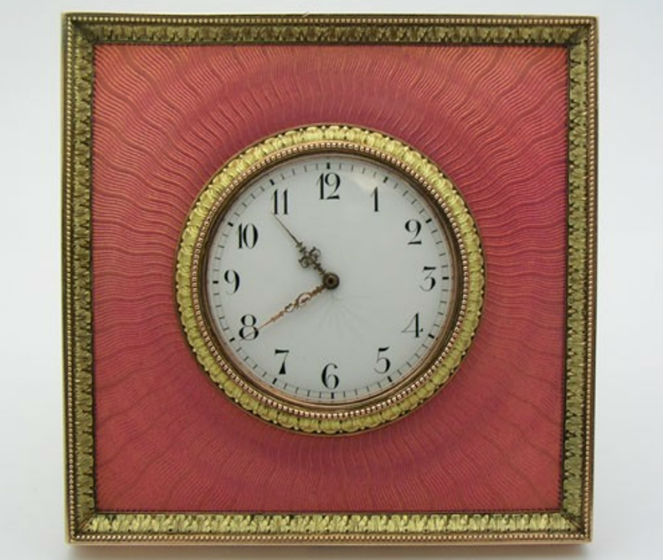
The most commonly produced fakes that Jackson sees today are fairly well crafted (as compared to the fakes made in the 1970s and 1980s) but are almost always overembellished with imperial insignia. “This means they almost always present themselves with diamond studded Imperial Double-Headed Eagles and in their ‘original box,'” he added.
The take-away here is the same as it is with any genre of antiques — caveat emptor (buyer beware) — it’s best to become an educated buyer and if in doubt, get an expert opinion before you buy.
Whether in imperial Russia at the turn of the 20th century when they were first made or in modern times, Faberge works are appreciated for their amazing craftsmanship and designs, making them highly sought after in today’s market.


